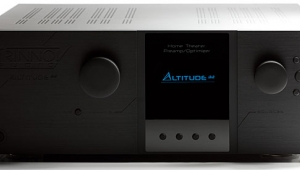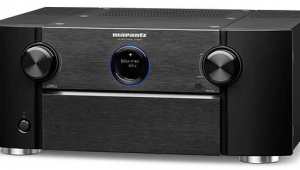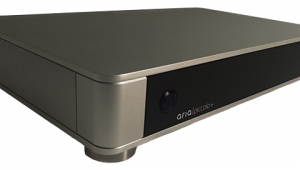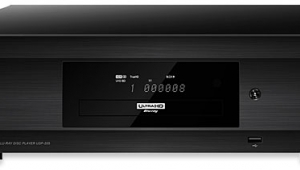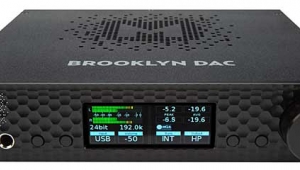| Columns Retired Columns & Blogs |
Music in the Round #23
My reviews of the TacT RCS (Stereophile, September 2001) and the Rives PARC (July 2003) are ample evidence that I've been fascinated with room equalization for quite a while. This is because I don't have a dedicated, purpose-built listening room in either of my homes, and having experienced what such rooms can do for recorded sound, I've always been somewhat dissatisfied with what I do have. Sure, I've got lots of great equipment, and a wife who understands enough to let me install some acoustic treatments (as long as she approves their appearance). Still, I'm sympathetic to those audiophiles who, when I suggest acoustic treatments to resolve their particular problems, say that it's simply not possible for them, either because of the Spousal Acceptance Factor or the need to accommodate other activities in the same room. Room equalizers seem to offer the hope for a panacea for what ails such spaces.
That's why I jumped at the chance to try out the Denon AVR-4806 ($3500) receiver, with built-in Audyssey MultEQxt room EQ software ("Music in the Round," January and March 2006). It promised to equalize the frequency and phase response of a multichannel system and to automate its operation. In practice, the MultEQxt system did, as advertised, improve the system's overall sound and was relatively easy to use. That said, questions were raised about MultEQxt's 1) effect on the fundamental clarity and resolution of each channel, 2) effectiveness in the low bass, and 3) limitations when built into a high-quality but nonetheless mass-market A/V receiver.
The MultEQxt software subjects the audio signal to additional processing, but keeps it within the same hardware signal path as when Audyssey is defeated. With the Denon AVR-4806 I could detect no effect on the music's clarity or resolution, apart from the intended EQ applied. The same criticism could be made of tone controls or Dolby Pro Logic, so I think that 1) is a red herring.
Audyssey has attacked issues 2) and 3) by offering the new, standalone Sound Equalizer with MultEQ Pro software ($2500). Now one can insert Audyssey EQ into any system that has line-level access between its sound processor and power amp. Because the Sound Equalizer has analog inputs and outputs, this means that it has analog-to-digital converters on its inputs and digital-to-analog converters on its outputs. While this is not as good as keeping the signal in the digital domain all the way, it does make the SE relatively future-proof—it won't have to be constantly updated to accommodate codec software for any and all digital formats (and they do seem to keep coming up). However, it also means that those ADCs and DACs better be damn good.
The other advance on built-in MultEQxt devices that must share system resources with other functions is that the Sound Equalizer is endowed with more powerful digital signal processing (DSP) that is entirely dedicated to equalization. The SE has twice the resolution of built-in versions of MultEQxt over most of the audioband, and eight times as much in the bass. The latter is accomplished by shifting filter taps to where they're most needed. In addition, the MultEQ Pro software offloads the measurement and calculation functions to a PC for even more effective and precise operation.
However—and it's a big however—the Sound Equalizer can be sold and installed only by a qualified professional who has taken Audyssey's training course. It also requires the use of a separately sold installation toolkit ($350) consisting of software, calibrated microphone, mike stand, mike preamp, and the necessary cables, all in a neat carrying case. But here's another however: I am the proof that any advanced audiophile with a few system installations under his belt can install a Sound Equalizer. Audyssey sent me one along with the toolkit; with access to feedback from Audyssey, I handily accomplished the task.
Description: The Sound Equalizer is a slim, clean, compact box about the size of one rack-space (about 1.75" high). Its front panel contains only one control and two LEDs. One LED indicates that it is powered; the other glows red when MultEQ Pro is off, green when on, as toggled by the switch. The rear panel has a main power switch adjacent to the IEC AC inlet, RS-232 and USB ports, two test ports, and two sets of eight RCA jacks each, for up to eight channels of input and output. I inserted the SE into my system with an NHT Controller as the input source, and the NHT Power5 power amplifier and my Paradigm Servo-15 subwoofer as outputs. I used another brace of Belkin PureAV Silver Series RCA cables (AV50300) to hook up the SE.
Installation: Installation of the software was trivial. It guides you through the process, step by step. Nonetheless, I can see the value of a training session; the onscreen and printed instructions are pretty terse, and there's no Help function or file to turn to. I had to e-mail Audyssey cofounder Chris Kyriakakis several times to get clarification of an operation.
- Log in or register to post comments


